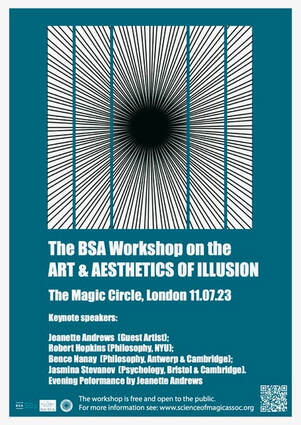|
This summer, Sarah Tuchel, and I will be traveling to London to present some of our work at the British Society of Aesthetics (BSA) Workshop on the Art & Aesthetics of Illusions, funded by BSA and co-sponsored by the Science of Magic Association (SoMA) and in collaboration with The Magic Circle Foundation (TMCF) and The Magic Circle (TMC). In collaboration with Gustav Kuhn and Dan Simons, we've been interviewing expert magicians in an attempt to find the boundaries of performance magic. Where does magic end and some other performance art begin? Here is the abstract for our presentation:  “[Magic] is so big that a simple definition seems impossible, so vague as to be an empty vessel waiting to be filled with meaning. How are we to determine what we are talking about when we use the word magic?” (Neale & Parr, 2002, The Magic Mirror, p. 6) Aside from The Magic Mirror, few published works in magic directly address magic’s underlying aesthetics or its theoretical basis. Instead, information is transmitted informally between magicians through lectures and personal conversations (see Rissanen et al., 2013). In order to try to capture some of this socially-disseminated information, we carried out a series of interviews with acclaimed, expert magicians. In these interviews, we probed their personal definitions of magic, their beliefs about what constitutes “good” and “bad” magic, and their attitudes about the aesthetic boundaries of performance magic. We report the outcomes of a thematic analysis of these interviews, highlighting points of agreement and disagreement across this small sample of experts in hopes that they will be a boon to future research in the Science of Magic. We will make the full text and video of these interviews publicly available (with participant consent) through the Science of Magic Association website.
0 Comments
Leave a Reply. |
AuthorI am an Associate Professor of Psychological Science at Carthage College, in Kenosha, Wisconsin. Archives
February 2024
Categories
All
|

 RSS Feed
RSS Feed
